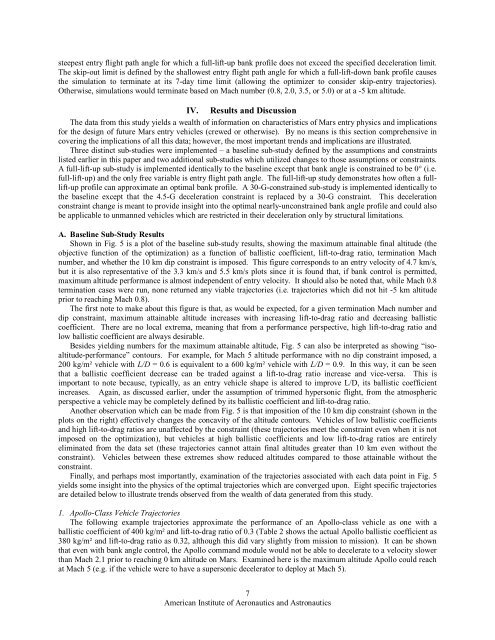Mars Entry Bank Profile Design for Terminal State Optimization
Mars Entry Bank Profile Design for Terminal State Optimization
Mars Entry Bank Profile Design for Terminal State Optimization
You also want an ePaper? Increase the reach of your titles
YUMPU automatically turns print PDFs into web optimized ePapers that Google loves.
steepest entry flight path angle <strong>for</strong> which a full-lift-up bank profile does not exceed the specified deceleration limit.<br />
The skip-out limit is defined by the shallowest entry flight path angle <strong>for</strong> which a full-lift-down bank profile causes<br />
the simulation to terminate at its 7-day time limit (allowing the optimizer to consider skip-entry trajectories).<br />
Otherwise, simulations would terminate based on Mach number (0.8, 2.0, 3.5, or 5.0) or at a -5 km altitude.<br />
IV. Results and Discussion<br />
The data from this study yields a wealth of in<strong>for</strong>mation on characteristics of <strong>Mars</strong> entry physics and implications<br />
<strong>for</strong> the design of future <strong>Mars</strong> entry vehicles (crewed or otherwise). By no means is this section comprehensive in<br />
covering the implications of all this data; however, the most important trends and implications are illustrated.<br />
Three distinct sub-studies were implemented – a baseline sub-study defined by the assumptions and constraints<br />
listed earlier in this paper and two additional sub-studies which utilized changes to those assumptions or constraints.<br />
A full-lift-up sub-study is implemented identically to the baseline except that bank angle is constrained to be 0° (i.e.<br />
full-lift-up) and the only free variable is entry flight path angle. The full-lift-up study demonstrates how often a fulllift-up<br />
profile can approximate an optimal bank profile. A 30-G-constrained sub-study is implemented identically to<br />
the baseline except that the 4.5-G deceleration constraint is replaced by a 30-G constraint. This deceleration<br />
constraint change is meant to provide insight into the optimal nearly-unconstrained bank angle profile and could also<br />
be applicable to unmanned vehicles which are restricted in their deceleration only by structural limitations.<br />
A. Baseline Sub-Study Results<br />
Shown in Fig. 5 is a plot of the baseline sub-study results, showing the maximum attainable final altitude (the<br />
objective function of the optimization) as a function of ballistic coefficient, lift-to-drag ratio, termination Mach<br />
number, and whether the 10 km dip constraint is imposed. This figure corresponds to an entry velocity of 4.7 km/s,<br />
but it is also representative of the 3.3 km/s and 5.5 km/s plots since it is found that, if bank control is permitted,<br />
maximum altitude per<strong>for</strong>mance is almost independent of entry velocity. It should also be noted that, while Mach 0.8<br />
termination cases were run, none returned any viable trajectories (i.e. trajectories which did not hit -5 km altitude<br />
prior to reaching Mach 0.8).<br />
The first note to make about this figure is that, as would be expected, <strong>for</strong> a given termination Mach number and<br />
dip constraint, maximum attainable altitude increases with increasing lift-to-drag ratio and decreasing ballistic<br />
coefficient. There are no local extrema, meaning that from a per<strong>for</strong>mance perspective, high lift-to-drag ratio and<br />
low ballistic coefficient are always desirable.<br />
Besides yielding numbers <strong>for</strong> the maximum attainable altitude, Fig. 5 can also be interpreted as showing “isoaltitude-per<strong>for</strong>mance”<br />
contours. For example, <strong>for</strong> Mach 5 altitude per<strong>for</strong>mance with no dip constraint imposed, a<br />
200 kg/m² vehicle with L/D = 0.6 is equivalent to a 600 kg/m² vehicle with L/D = 0.9. In this way, it can be seen<br />
that a ballistic coefficient decrease can be traded against a lift-to-drag ratio increase and vice-versa. This is<br />
important to note because, typically, as an entry vehicle shape is altered to improve L/D, its ballistic coefficient<br />
increases. Again, as discussed earlier, under the assumption of trimmed hypersonic flight, from the atmospheric<br />
perspective a vehicle may be completely defined by its ballistic coefficient and lift-to-drag ratio.<br />
Another observation which can be made from Fig. 5 is that imposition of the 10 km dip constraint (shown in the<br />
plots on the right) effectively changes the concavity of the altitude contours. Vehicles of low ballistic coefficients<br />
and high lift-to-drag ratios are unaffected by the constraint (these trajectories meet the constraint even when it is not<br />
imposed on the optimization), but vehicles at high ballistic coefficients and low lift-to-drag ratios are entirely<br />
eliminated from the data set (these trajectories cannot attain final altitudes greater than 10 km even without the<br />
constraint). Vehicles between these extremes show reduced altitudes compared to those attainable without the<br />
constraint.<br />
Finally, and perhaps most importantly, examination of the trajectories associated with each data point in Fig. 5<br />
yields some insight into the physics of the optimal trajectories which are converged upon. Eight specific trajectories<br />
are detailed below to illustrate trends observed from the wealth of data generated from this study.<br />
1. Apollo-Class Vehicle Trajectories<br />
The following example trajectories approximate the per<strong>for</strong>mance of an Apollo-class vehicle as one with a<br />
ballistic coefficient of 400 kg/m² and lift-to-drag ratio of 0.3 (Table 2 shows the actual Apollo ballistic coefficient as<br />
380 kg/m² and lift-to-drag ratio as 0.32, although this did vary slightly from mission to mission). It can be shown<br />
that even with bank angle control, the Apollo command module would not be able to decelerate to a velocity slower<br />
than Mach 2.1 prior to reaching 0 km altitude on <strong>Mars</strong>. Examined here is the maximum altitude Apollo could reach<br />
at Mach 5 (e.g. if the vehicle were to have a supersonic decelerator to deploy at Mach 5).<br />
7<br />
American Institute of Aeronautics and Astronautics
















